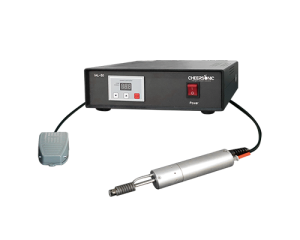ultrasonic Butterfy welding technology
The core of ultrasonic butterfly welding lies in achieving the welding of materials by utilizing the high-frequency vibration energy of ultrasonic waves. The ultrasonic generator in the equipment converts industrial frequency alternating current into high-frequency electrical signals, with frequencies typically ranging from 20kHz to 40kHz. These signals are transmitted to the transducer, which, based on the piezoelectric effect, converts high-frequency electrical energy into mechanical vibrations of the same frequency. The mechanical vibration is amplified by the amplitude transformer and then transmitted to the welding head. When the welding head comes into contact with the material to be welded, the high-frequency vibration causes the molecules on the material surface to rub against each other, generating heat and resulting in local melting of the material or putting it in a viscous flow state.
I. Characteristics and Advantages of Ultrasonic Butterfly Welding Technology
(1) High efficiency and precision
Compared with traditional welding methods, ultrasonic butterfly welding has an extremely fast welding speed, with a single welding time usually ranging from 0.5 to 2 seconds. It can significantly enhance production efficiency and is particularly suitable for large-scale assembly line production. Meanwhile, by precisely controlling parameters such as the power of ultrasonic waves, welding time and pressure, the welding position and strength can be precisely controlled, enabling the completion of micron-level precision welding operations and meeting the manufacturing requirements of various precision products.
(2) High quality and good appearance
During the welding process, due to the small heat-affected zone, the material is not prone to deformation and can maintain its original physical and chemical properties to the greatest extent. After the welding is completed, the surface of the formed weld points is smooth and flat, without obvious defects such as welding slag and pores. The appearance is exquisite, and the pattern similar to the wings of a butterfly has a unique decorative value. It has a great advantage in the manufacturing of products with high appearance requirements, such as electronic product shells and handicrafts.
(3) Environmental protection and energy conservation
Ultrasonic butterfly welding does not require the use of fluxes, adhesives or other chemical substances, avoiding the pollution of chemical substances to the environment and the potential harm to the health of operators. Meanwhile, this technology mainly relies on ultrasonic vibration to generate heat, with a high energy utilization rate. Compared with some welding methods that rely on high heat to melt materials, its energy consumption is significantly reduced, which is in line with the development trend of green manufacturing.
Ii. Application Fields of Ultrasonic Butterfly Welding
(1) Electronic and Electrical industry
Ultrasonic butterfly welding is widely used in the field of electronics and electrical appliances, for welding the shells of products such as mobile phone cases and tablet shells, achieving seamless connection, ensuring aesthetics and sealing, and protecting internal components. At the same time, improve production efficiency and quality in battery packaging and circuit board assembly soldering.
(II) Medical device industry
With its environmental friendliness and material performance maintaining advantages, ultrasonic butterfly welding has played a significant role in the manufacturing of medical devices. It is commonly used in the welding of medical catheters, infusion bags and other products to ensure no chemical residues, meet hygiene standards, and guarantee the sealing and strength of the products.
(3) Automotive interior industry
In the production of automotive interiors, this technology is applied to the splicing of seat fabrics, the welding of instrument panel shells, etc., to achieve the welding of different materials, enhance production efficiency, make the interior appearance more exquisite, and improve the quality and comfort of the car.
With the development of artificial intelligence and Internet of Things technologies, ultrasonic butterfly welding equipment will accelerate its intelligent upgrade in the future. Intelligent sensors and control systems can monitor welding parameters such as temperature and pressure in real time and automatically optimize them according to preset programs. With the help of the Internet of Things, devices are seamlessly connected to the production management system, achieving remote monitoring, fault early warning and intelligent data analysis, and comprehensively enhancing the efficiency of production management and the stability of equipment.

